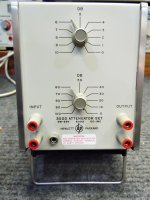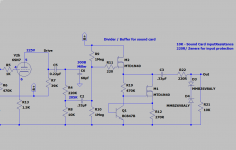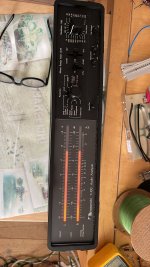I need some advice on distortion measurements. I currently have a Heathkit HD1 Distortion meter and also a LabVIEW set up using a 14 bit DAQ. The LabVIEW set up works quite well for the most part. I get THD, SINAD, Frequency and amplitude (P-P) along with a FFT graph. I had to pass on the Heathkit as it cant measure very low distortion. My problem is I have hit the floor of what the LV set up can measure. The lowest THD I can measure is 0.07% . This could be do to my measurement technique, I am taking the output of an ultra low THD sine wave generator from Victor and feeding it into the Analog in A0, and ground on the DAQ. My eventual goal is to use this Sine generator to measure the THD from the 1st stage of a 12AU7 . Currently I use the same measurement technique to measure the the 12AU7 , I take the signal from the Plate of the 12AU7 and connect it and ground to the LV DAQ in the same manner as described above. All this is single ended , should I be using a transformer?
Thanks,
Alan
Thanks,
Alan
The DAQ is not really optimised for audio I'm guessing. A 14bit ADC might get you down to 0.02% distortion in practice, but the DAQ might have rather noisy voltage regulators or non ideal grounding, who knows.
Check out https://www.diyaudio.com/community/threads/how-to-distortion-measurements-with-rew.338511/. A soundcard and free REW software along with Victor's oscillator do the job for you.
Merlinb, What in your opinion would be the proper way to take the signal out of the first stage of a 12AU7 preamp and feed it to a distortion analyzer. Would you simply take the signal from the Plate and take ground then connect them to the analyzer? I want to measure the distortion from stage 1 before building stage 2.
Great article, I have read a few similar and do eventually want to go there soon. I have the same question. Do I need to run through a transformer or just take the signal from the Plate and ground and feed it the sound card. I am not using a completed amp, all the sound card examples show a completed amp.Check out https://www.diyaudio.com/community/threads/how-to-distortion-measurements-with-rew.338511/. A soundcard and free REW software along with Victor's oscillator do the job for you.
It depends on the input impedance of the anaylzer. I generally tap-off the signal from further up the plate resistor, so the input impedance is no longer loading the tube. I also include a neon lamp to ground as a voltage clamp. However, PSU noise will get into some measurements this way,Merlinb, What in your opinion would be the proper way to take the signal out of the first stage of a 12AU7 preamp and feed it to a distortion analyzer. Would you simply take the signal from the Plate and take ground then connect them to the analyzer? I want to measure the distortion from stage 1 before building stage 2.
If the PSU is too noisy to get the measurement I need, I buffer the tube with a MOSFET source follower and let that drive the analyzer. If the analyzer cannot tolerate large voltages safely, I will tap off further down the MOSFET source resistor.
Last edited:
I would capacitor couple to a load resistor and measure from that. You could use a resistor voltage divider and and LEDs to clip the signal. I made a switch box which does this. On the Akitika website, there is a link at the bottom of this page, https://www.akitika.com/1kHzOscillator.html#OscillatorManual, which shows how to build this switched attenuator.
I have used LabVIEW to measure distortion before and the thd functions are capable but instead of the daq card I would use a sound card, you would have to rewrite some of the code to use the sound card drivers.
To measure the ultra low distortion oscillator boards you also need to add a passive notch filter to notch the fundamental and I have used REW which has the option to account for the a notch filter use by the user supplying the fundamental level.
To measure the ultra low distortion oscillator boards you also need to add a passive notch filter to notch the fundamental and I have used REW which has the option to account for the a notch filter use by the user supplying the fundamental level.
Thank you for this link! as I was looking at the diagram of the attenuator I thought, I think I have an attenuator from the "OLD days" somewhere. I just found it! an HP 350D Attenuation set . I can dial up any thing from 0 to 110 DBIOn the Akitika website, there is a link at the bottom of this page, https://www.akitika.com/1kHzOscillator.html#OscillatorManual, which shows how to build this switched attenuator.
Between us, my building partner (itishifi.com) and I have three 1700 series Sound Tech's, a 1700B, a 1701A and a 1710. These were the darlings of the late 1970s/ early 1980s, but it's next to difficult to keep them running these many decades later. Unobtainium optocouplers, etc. keep the oscillators and the distortion nulling stuff marginally working, downhill with a tailwind. But!
If y'all have access to one for cheap, because that's what a non-working one should cost, or maybe a gift from a local geezer, they'd make a great input interface, including excellent metering of the (truly differential) input, with both signal and chassis/Earth grounding separately available. The "input monitor" BNC output was a factory option (option 003? 004?) but trivially easy to install if yours is without. This is the interfaced output to feed your ADC.
These were a joy to use, back in the day, but can still be useful in the modern context of an ADC and a laptop on battery power. That's where we're going right now.
All good fortune,
Chris
If y'all have access to one for cheap, because that's what a non-working one should cost, or maybe a gift from a local geezer, they'd make a great input interface, including excellent metering of the (truly differential) input, with both signal and chassis/Earth grounding separately available. The "input monitor" BNC output was a factory option (option 003? 004?) but trivially easy to install if yours is without. This is the interfaced output to feed your ADC.
These were a joy to use, back in the day, but can still be useful in the modern context of an ADC and a laptop on battery power. That's where we're going right now.
All good fortune,
Chris
If you're looking to buy a sound card for this, I recommend the ones by Focusrite. Their gear is well spec'ed. The Scarlett Solo or 2i2 would be plenty.
Tom
Tom
Much thanks for the recommendation. I have an old Tascam thing with phantom power and such, but has some sort of line inputs. Maybe, maybe enough dynamic range for the kind of things we're currently cooking - old fashioned valve amplifiers, monotonic by nature, so really only anything bigger than 60dB dynamic range works - for right now. But serious work on preamp-level distortion or better output amplifiers needs better. The Solo looks great. Thanks.
And! an oscillator better than a wobbly 40+ year old Sound Tech (I'm sorry, I love you, but I have to speak my truth!!!) or our HP209x. Thanks to diyAudio, one of Victor's oscillators is also immediately next.
All good fortune,
Chris
And! an oscillator better than a wobbly 40+ year old Sound Tech (I'm sorry, I love you, but I have to speak my truth!!!) or our HP209x. Thanks to diyAudio, one of Victor's oscillators is also immediately next.
All good fortune,
Chris
Ha,ha I ordered a Scarlett Solo already. Be here tomorrow. plan to start with ARTA SW, what are you using? One quick question, what is the desired input voltage into this thing? I was thinking 1V P2PIf you're looking to buy a sound card for this, I recommend the ones by Focusrite. Their gear is well spec'ed. The Scarlett Solo or 2i2 would be plenty.
Tom
Victor is a Joy to deal with. Excellent communication, just a little lag time between the US and Latvia. Great advice both before and after the sale. They are built to order , so takes a few days to ship. Distortion is not even measurable with most equipment. I was using an HP3311A until I measured the distortion at 1.7% at 1K, dug out my Heathkit IG-18, after calibration I had 0.24. Built a cheap OP Amp filter got down to 0.17 ,. with Victors I measured 0.07 thats when I realized my measurement ability was limited by the LabVIEW set up I was using. Now on to the 24Bit sound card.And! an oscillator better than a wobbly 40+ year old Sound Tech (I'm sorry, I love you, but I have to speak my truth!!!) or our HP209x. Thanks to diyAudio, one of Victor's oscillators is also immediately next.
When feeding a signal from a HV source one should capacitively couple it to a resistive divider (representing the next stage input resistance) and again capacitively couple it to a buffer such as a FET on top with a current source on the bottom. Then couple it to a series resistor and a pair of low voltage (3.6V) zener clamps.
High voltage spikes when you turn on your amp can destroy the sound card. Don't ask how I know.
The resistive divider should be a high impedance one so as not to load the stage you are measuring. Choose the reisistive divider to give 1Vrms at full output (1Vrms or whatever your sound card will accept without it's input distorting). For example, my Xonar SE starts clipping on input at just over 1Vrms.
In my example, the 6SN7 under test is meant to drive a 300B, so I used about 230K for the divider in parallel with a 68pF cap representing the input capacitance of the 300B to drive the buffer.
Don't heavily load the UUT, or you will introduce additional distortion.
High voltage spikes when you turn on your amp can destroy the sound card. Don't ask how I know.
The resistive divider should be a high impedance one so as not to load the stage you are measuring. Choose the reisistive divider to give 1Vrms at full output (1Vrms or whatever your sound card will accept without it's input distorting). For example, my Xonar SE starts clipping on input at just over 1Vrms.
In my example, the 6SN7 under test is meant to drive a 300B, so I used about 230K for the divider in parallel with a 68pF cap representing the input capacitance of the 300B to drive the buffer.
Don't heavily load the UUT, or you will introduce additional distortion.
Attachments
Last edited:
Victor is a Joy to deal with. Excellent communication, just a little lag time between the US and Latvia. Great advice both before and after the sale. They are built to order , so takes a few days to ship. Distortion is not even measurable with most equipment. I was using an HP3311A until I measured the distortion at 1.7% at 1K, dug out my Heathkit IG-18, after calibration I had 0.24. Built a cheap OP Amp filter got down to 0.17 ,. with Victors I measured 0.07 thats when I realized my measurement ability was limited by the LabVIEW set up I was using. Now on to the 24Bit sound card.
It shows the noise floor of my Amber analyzer. It reads 0.0007%.
In some cases i just use a test cd with various sine waves etc. Distortion is extreemly low as these have been gereated digitally (not all digital is bad)
Anyway, with Labview a sinewave can be generated as well….
I think you need to build a buffer first ( as this can be done with ulta low distortion it will not add much during measurements).
Anyway, with Labview a sinewave can be generated as well….
I think you need to build a buffer first ( as this can be done with ulta low distortion it will not add much during measurements).
Attachments
- Home
- Amplifiers
- Tubes / Valves
- Help with Distortion Measurements


